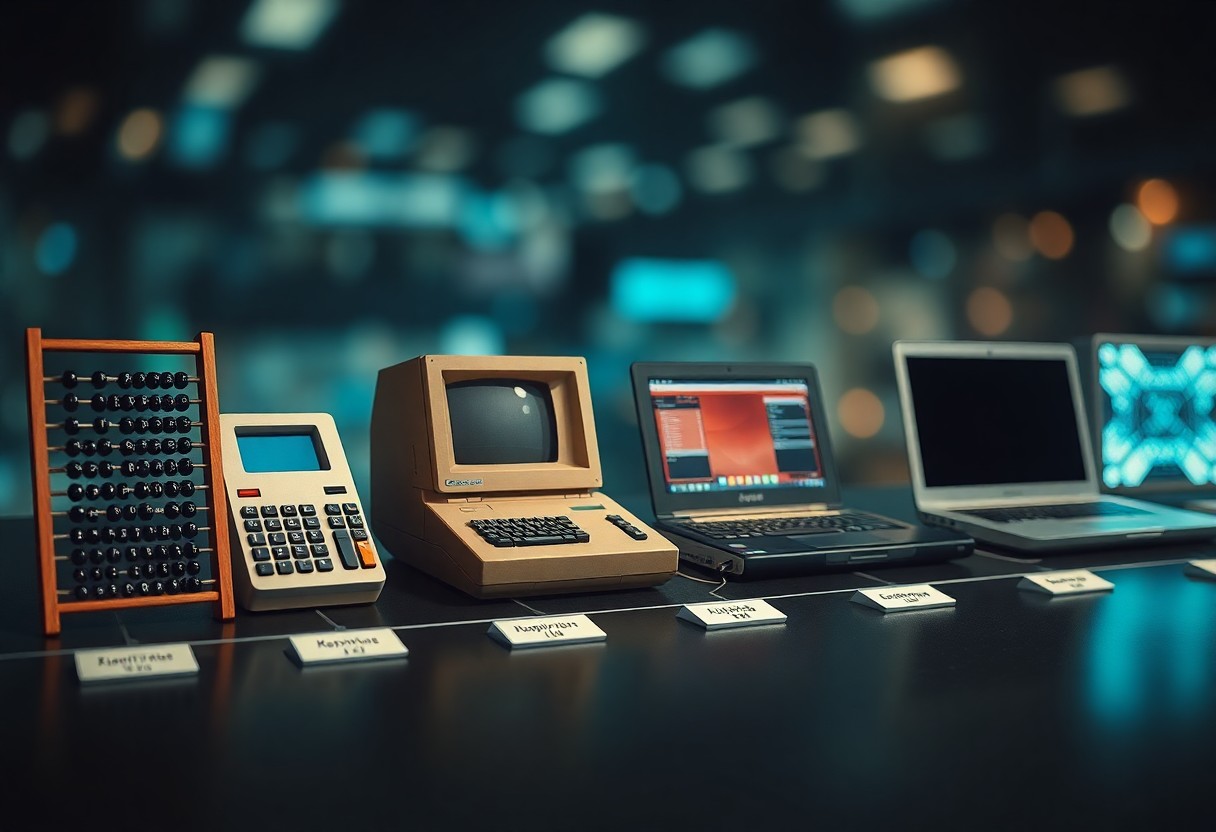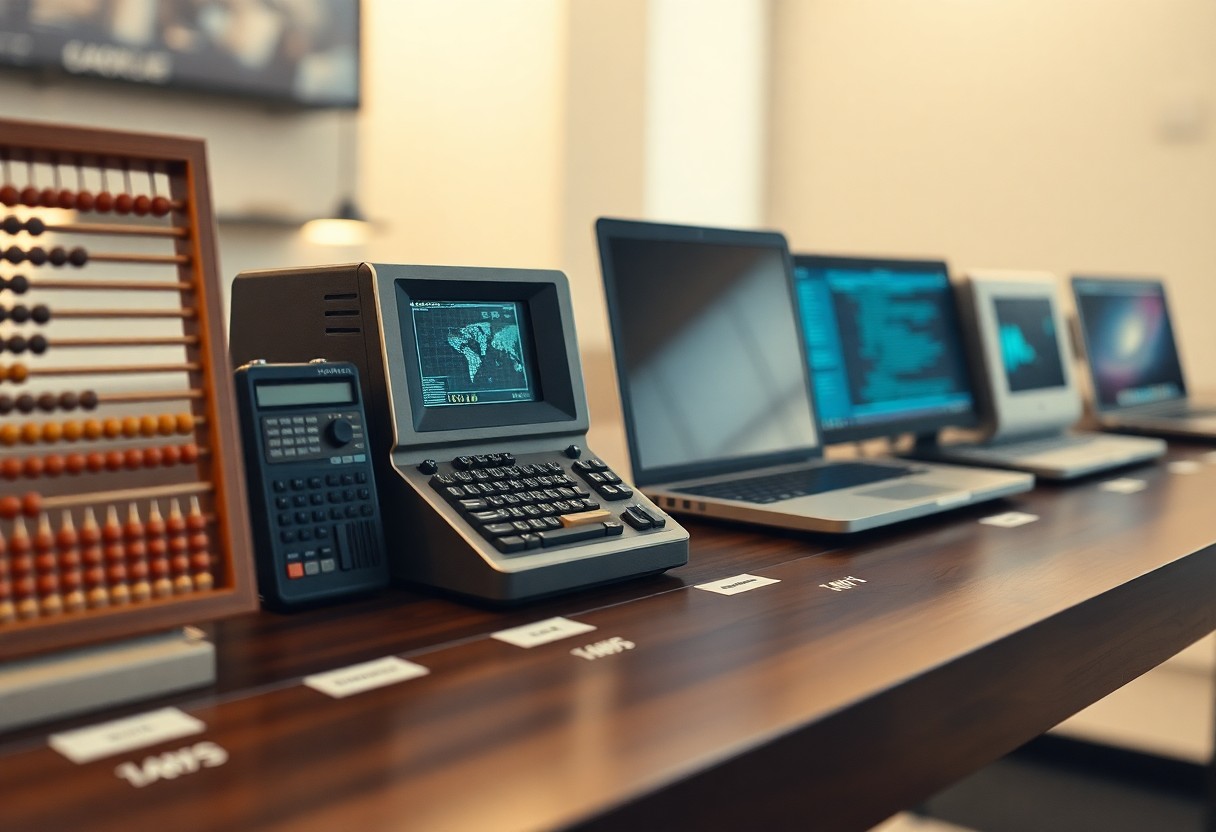Most people may not realize that the journey of computing has been filled with groundbreaking inventions and transformative innovations that have shaped the modern world. From the early mechanical calculators to today’s advanced artificial intelligence, the evolution of computing technology has had profound effects on society and industry alike. By exploring this timeline, you will gain an insightful perspective on how your everyday devices came to be, the challenges faced along the way, and the exciting future that lies ahead in computing.
Early Mechanical Computing
For centuries, humanity has sought ways to simplify complex calculations, leading to the birth of mechanical computing. Early devices, like the abacus and astrolabe, laid the groundwork for a new era of computation. These innovations enabled mathematicians and scientists to perform intricate calculations with greater accuracy and efficiency, paving the way for modern computing technologies.
The Antikythera Mechanism
Along the coast of Greece, a remarkable ancient artifact, known as the Antikythera Mechanism, was discovered. This intricate gear-based device is believed to have been created around 150–100 BCE and functioned as an early analog computer. It was capable of predicting celestial events and eclipses, showcasing the advanced understanding of astronomy possessed by ancient civilizations.
Charles Babbage and the Analytical Engine
Before the development of modern computers, you may be interested to learn about Charles Babbage and his remarkable invention, the Analytical Engine. This machine was designed to perform a variety of calculations, representing a pivotal moment in computing history as it introduced the concept of programmability.
Babbage envisioned the Analytical Engine as a machine capable of executing any mathematical operation, utilizing punch cards for input, much like a modern programming language. His design included components such as an arithmetic logic unit, memory, and the ability to make conditional decisions. Although Babbage struggled with funding and technical challenges, his revolutionary ideas laid the groundwork for contemporary computing and inspired future pioneers to develop versatile machines that would ultimately enhance your daily life.
1. 1940s: First electronic computers developed for military use.
2. 1950s: Transistors replace vacuum tubes, improving efficiency.
3. 1960s: Mainframe computers dominate business and academia landscapes.
4. 1970s: Microprocessors enable personal computers for home users.
5. 1980s: Graphical user interfaces revolutionize user interaction.
6. 1990s: Internet emerges, transforming global communication and commerce.
The Advent of Electronic Computers
If you are curious about the origins of electronic computing, you can explore a comprehensive history through the Welcome | Timeline of Computer History. This era marked the beginning of a new age, where machines could process information faster and more efficiently than ever before, laying the groundwork for the sophisticated technology we use today.
ENIAC: The First General-Purpose Computer
Between 1945 and 1946, the development of the Electronic Numerical Integrator and Computer (ENIAC) revolutionized computing as the first general-purpose computer. Designed to perform complex calculations quickly, ENIAC paved the way for future advancements in computing technology, showcasing what was possible with this innovative electronic architecture.
The Transition from Vacuum Tubes to Transistors
Behind the scenes of early computing, the shift from vacuum tubes to transistors marked a significant turning point in electronics. This shift allowed computers to become smaller, more reliable, and energy-efficient as transistors replaced fragile vacuum tubes, drastically reducing heat output and improving performance.
Hence, the transition from vacuum tubes to transistors not only transformed computer design but also enhanced their reliability and efficiency. With transistors, computers became smaller and cheaper to manufacture, opening the door for a new wave of innovation. While vacuum tubes were notorious for their high failure rates and required a lot of power, transistors offered a more durable and compact solution. This evolution marked the beginning of modern computing, paving the way for the complex systems you rely on today.
The Birth of Personal Computing
Your introduction to personal computing marks a significant shift in technology, transforming how individuals interact with computers. As these devices became more accessible, you witnessed a democratization of technology, ultimately leading to an era where computing power resides in your very hands.
The Altair 8800 and the Rise of DIY Computers
To launch on personal computing, enthusiasts flocked to the Altair 8800, a game-changing microcomputer kit that ignited a passion for DIY computing. You could assemble it at home, paving the way for innovation and creative experimentation in technology.
Apple, IBM, and the PC Revolution
Altair’s success spurred rivals like Apple and IBM, setting the stage for the PC revolution. These companies played a pivotal role in making computers user-friendly and widely available, allowing you to integrate technology seamlessly into your daily life.
Plus, the arrival of Apple’s Apple II and IBM’s PC reshaped the landscape of personal computing with their user-friendly interfaces and robust software ecosystems. These innovations not only enhanced productivity but also sparked a new wave of entrepreneurial ventures.

The Internet and Networking
Unlike the earlier, isolated computing environments, the advent of the Internet transformed how you connect, communicate, and access information. By interlinking computers across the globe, networking paved the way for an unprecedented sharing of ideas and resources, influencing industries, education, and daily life, while also creating new challenges regarding privacy and security.
ARPANET: The Genesis of the Internet
To understand the origin of the Internet, you need to look at ARPANET, funded by the U.S. Department of Defense in the late 1960s. This pioneering project established the first packet-switching network, enabling multiple computers to communicate simultaneously, laying the foundational architecture that supports the Internet today.
The World Wide Web and Its Impact
The World Wide Web revolutionized how you access and share information, allowing you to navigate through a vast array of online content with ease. Its introduction in the early 1990s made the Internet more user-friendly and accessible, sparking an explosion of websites that transformed commerce, education, and social interactions.
But the impact of the World Wide Web extends beyond convenience; it has shaped your world in both positive and negative ways. On one hand, it has democratized information, allowing you to access knowledge and services anytime, anywhere. On the other hand, the rise of misinformation, cyber threats, and data privacy issues has created a landscape where vigilance is imperative. As you engage with the Web, being mindful of its potential risks and embracing its transformative power is vital for navigating this interconnected digital era.
Mobile Computing
To understand the impact of mobile computing, you must consider how it transformed the way you interact with technology. The development of portable devices has made information accessible anytime and anywhere, creating a new era where convenience and connectivity dominate your daily life. As you carry powerful devices in your pocket, you gain the ability to communicate, work, and entertain yourself on the go, marking a significant shift in computing history.
The Emergence of Smartphones
Along with the introduction of smartphones in the early 2000s, a revolution in mobile computing began. These devices combined the functionalities of a phone with those of a computer, enabling you to access data, browse the internet, and utilize applications all from one compact gadget. The launch of Apple’s iPhone in 2007 marked a defining moment, paving the way for countless innovations and setting new standards in mobile technology.
The Evolution of Tablets
Any discussion of mobile computing must include the rise of tablets, which bridged the gap between smartphones and traditional laptops. These devices offered larger screens and enhanced functionality, appealing to both casual users and professionals alike. As you navigate through various applications, the tablet’s versatility allows for seamless transitions between tasks such as reading, gaming, and working on documents, reinforcing its importance in today’s tech landscape.
This evolution of tablets introduced features that transformed user experiences, such as touchscreens, high-resolution displays, and app ecosystems that provided immense possibilities for productivity and entertainment. While you enjoy the convenience of portability, it’s vital to acknowledge the security concerns and privacy issues that accompany increased online access. As tablets continue to evolve, they bring forth new opportunities for innovation and integration into your everyday life, encouraging you to stay engaged with the ever-changing digital world.
The Era of Artificial Intelligence
Once again, society stands on the brink of transformation with the rise of Artificial Intelligence (AI). This era has reshaped industries, altered job landscapes, and pushed the boundaries of what machines are capable of achieving. From autonomous vehicles to intelligent personal assistants, AI is not just a buzzword but a fundamental aspect of your daily life, influencing decisions and experiences that were once unimaginable.
Early AI Research and Breakthroughs
Early efforts in AI research during the 1950s and 60s laid the groundwork for modern computing. Pioneers like Alan Turing proposed theories on machine intelligence, while projects such as the Dartmouth Conference crystallized the vision of creating machines capable of reasoning. These initial steps, albeit simple, marked the beginning of a journey toward creating devices that could perform tasks requiring human-like thought.
Machine Learning and Deep Learning Advances
Artificial Intelligence has seen remarkable progress in the fields of machine learning and deep learning. These advanced technologies enable systems to learn from data and improve over time, leading to innovations in natural language processing, image recognition, and predictive analytics. The application of these techniques in various domains is revolutionizing how you interact with technology daily.
A significant aspect of AI’s growth is its fusion with machine learning and deep learning. This combination has fortified algorithms that have improved the accuracy and efficiency of AI systems. You benefit from personalized recommendations in streaming services, smarter chatbots responding to your inquiries, and healthcare solutions predicting patient outcomes. However, these advances carry risks such as biases in algorithmic decision-making and potential job displacement. It’s vital to consider the dual nature of these technologies, as they can both drive innovation and pose serious ethical dilemmas as they evolve in the coming years.
To wrap up
Considering all points, understanding the timeline of computing history enhances your appreciation of how technology has evolved and shaped our world. From the earliest mechanical devices to modern-day artificial intelligence, each milestone reflects human ingenuity and curiosity. By familiarizing yourself with these developments, you gain insight into the interconnectedness of past, present, and future technologies, which can inform your perspective on ongoing advancements in computing and their implications for society.




